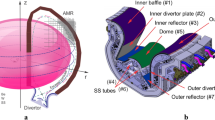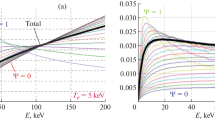Abstract
A neutronics analysis using the Monte Carlo method is carried out for the end-plug penetration and magnet system of a tandem mirror fusion reactor. Detailed penetration and the magnets' three-dimensional configurations are modeled. A method of position dependent angular source biasing is developed to adequately sample the DT fusion source in the central cell region and obtain flux contributions at the penetration components.
To assure cryogenic stability, the barrier cylindrical solenoid is identified as needing substantial shielding of about 1 m of a steel-lead-boron-carbide-water mixture. Heating rates there would require a thermal-hydraulic design similar to that in the central cell blanket region. The transition coils, however, need a minimal 0.2 m thickness shield. The leakage neutron flux at the direct converters is estimated at 1.3×1015 n/(m2·s), two orders of magnitude lower than that reported at the neutral beam injectors for tokamaks around 1017 n/(m2·s) for a 1 MW/m2 14 MeV neutron wall loading. This result is obtained through a coupling between the nuclear and plasma physics designs in which hydrogen ions rather than deuterium atoms are used for energy injection at the end plug, to avoid creating a neutron source there. This lower and controllable radiation leakage problem is perceived as a potential major advantage of tandem mirrors compared to tokamaks and laser reactor systems.
Similar content being viewed by others
References
B. Badger et al., Preliminary information on the University of Wisconsin tandem mirror reactor design, University of Wisconsin, Fusion Engineering Program, UWFDM-325 (November 1979).
R. W. Moir et al., Preliminary design study of the tandem mirror reactor (TMR), Lawrence Livermore Laboratory, UCRL-52302 (July 1977).
J. Jung and M. A. Abdou, Radiation shielding of major penetrations in tokamak reactors,Nucl. Technol. 41:71 (November 1978).
M. M. H. Ragheb, A. C. Klein, and C. W. Maynard, Three-dimensional neutronics analysis of the mirrors-beam duct-shield system for a laser-driven power reactor, University of Wisconsin, Fusion Engineering Program, UWFDM-239 (April 1978).
M. M. H. Ragheb, A. C. Klein, and C. W. Maynard, Neutronics shielding analysis of the last-mirrors-beam duct system for a laser fusion power reactor,Nucl. Technol. Fusion,1:99 (1981).
Radiation Shielding Information Center, MORSE-CG, Oak Ridge National Laboratory (1978).
W. E. Ford III, R. T. Santoro, R. W. Roussin, and D. M. Plaster, Modification number one to the coupled 100n-218 cross section library for EPR calculations, ORNL/TM-5249, Oak Ridge National Laboratory (1976).
M. A. Abdou and R. W. Roussin, “MACKLIB, 100-group neutron fluence-to-kerma factors and reaction cross sections generated by the MACK computer program from data in ENDF format, ONRL/TM-3706, Oak Ridge National Laboratory (1976).
R. W. Moir, W. L. Barr, and G. H. Miley, Surface requirements for electrostatic direct energy converters, UCRL-75323, Lawrence Livermore Laboratory (January 1974).
M. M. H. Ragheb, Optimized fissile and fusile breeding in a laser-fusion fissile-enrichment flux trap blanket,Journal of Fusion Energy, 1, No. 3 (1981).
M. A. Abdou, Nuclear design of the blanket/shield system for a tokamak experimental power reactor, ANL/CTR/TM-51, Argonne National Laboratory (July 1979).
Author information
Authors and Affiliations
Rights and permissions
About this article
Cite this article
Ragheb, M.M.H., Maynard, C.W. Neutronics shielding analysis for the end plug of a tandem mirror fusion reactor. J Fusion Energ 1, 367–380 (1981). https://doi.org/10.1007/BF01050302
Received:
Issue Date:
DOI: https://doi.org/10.1007/BF01050302




